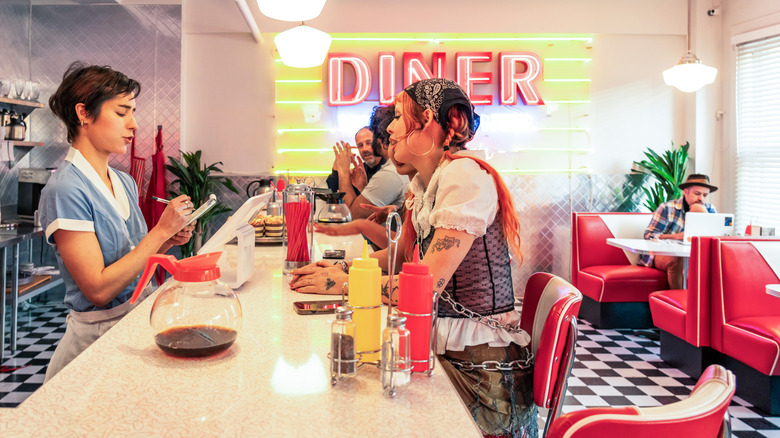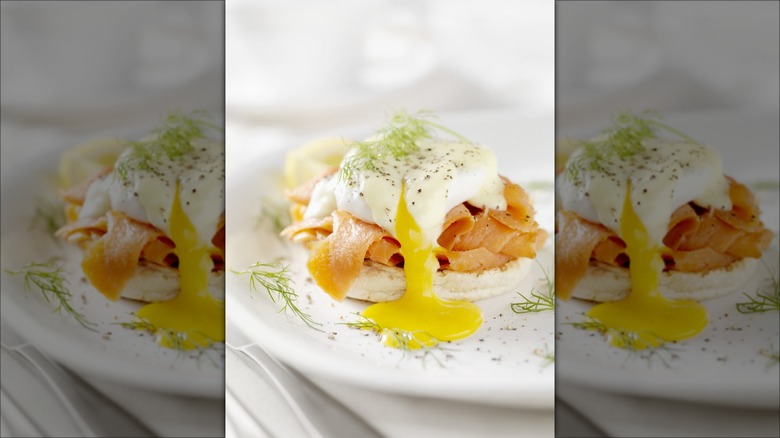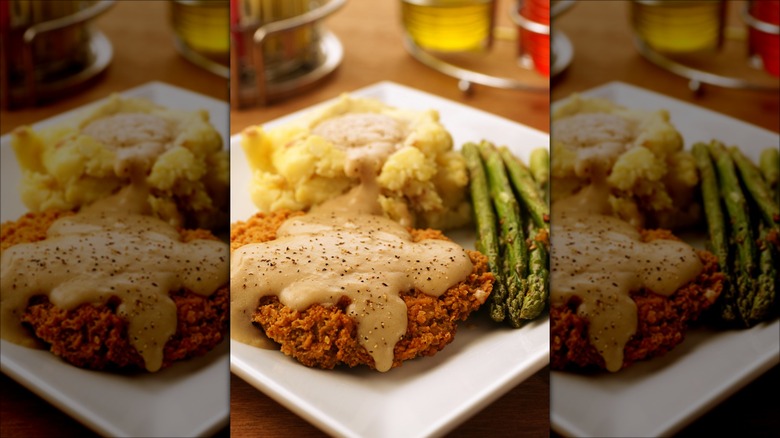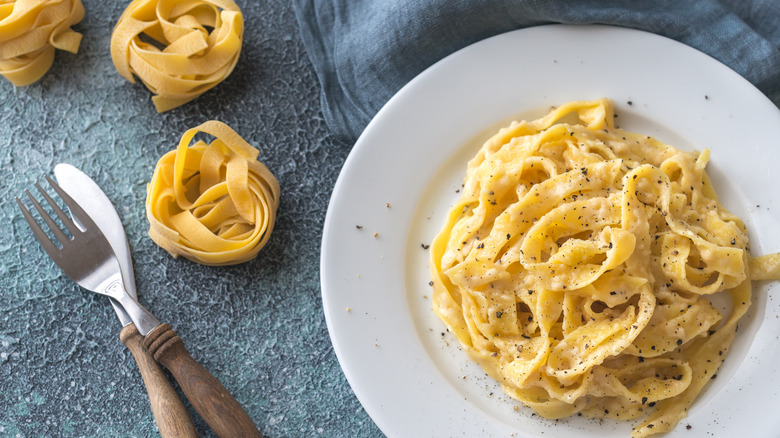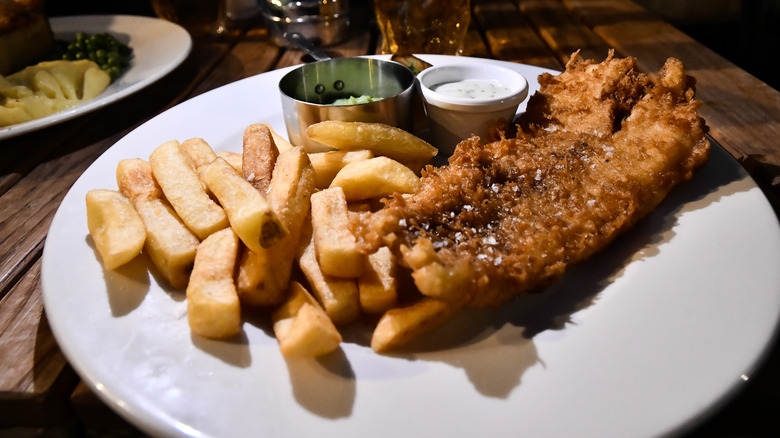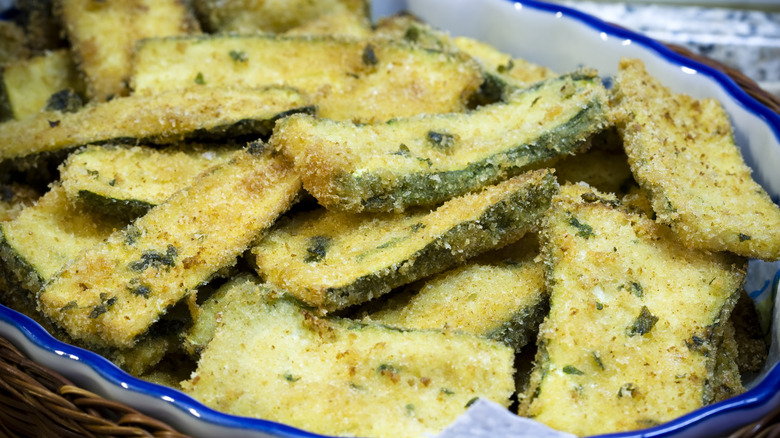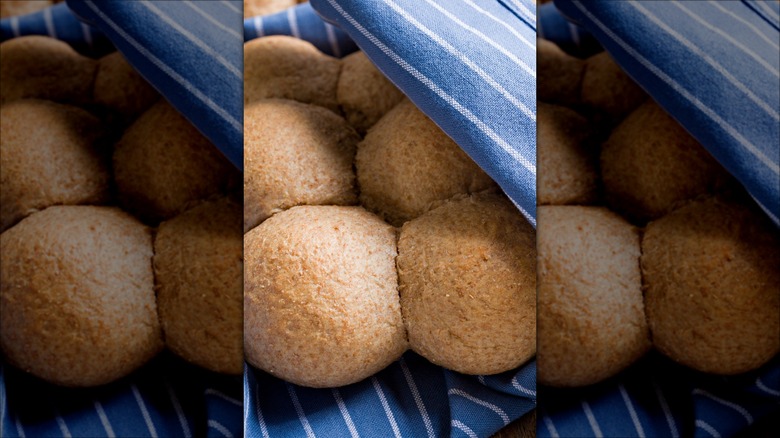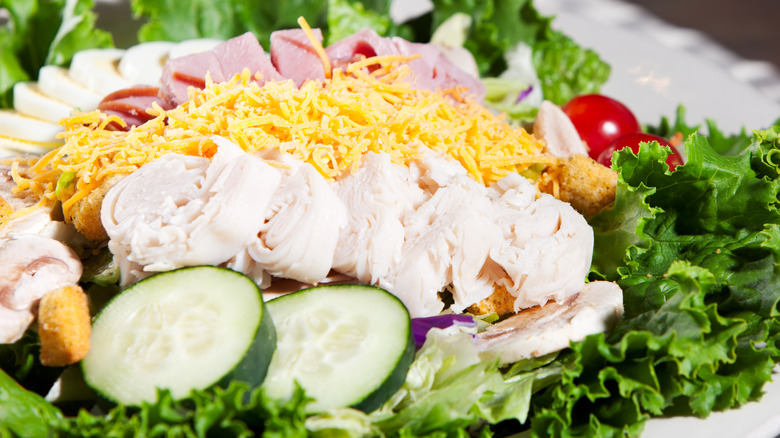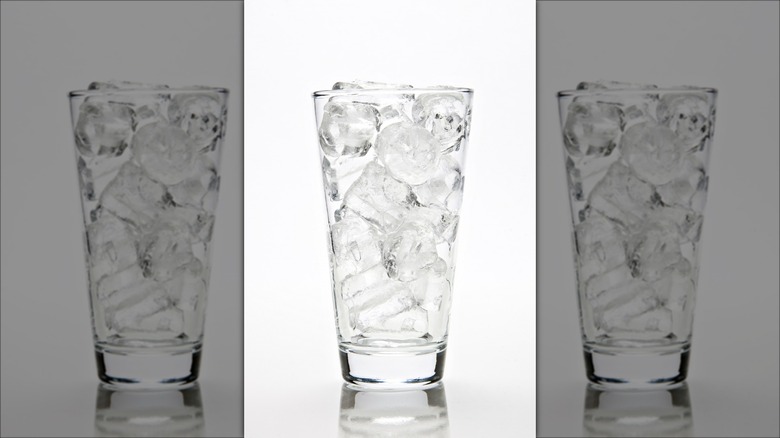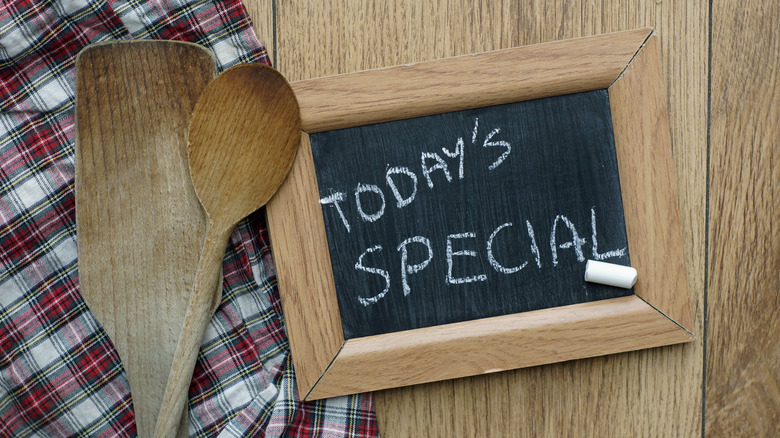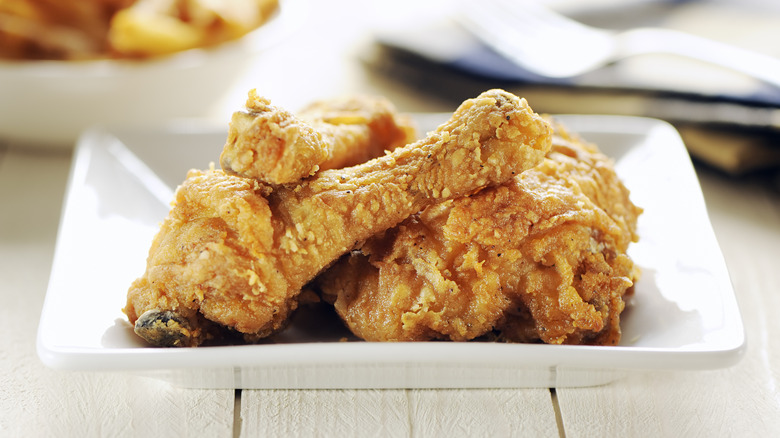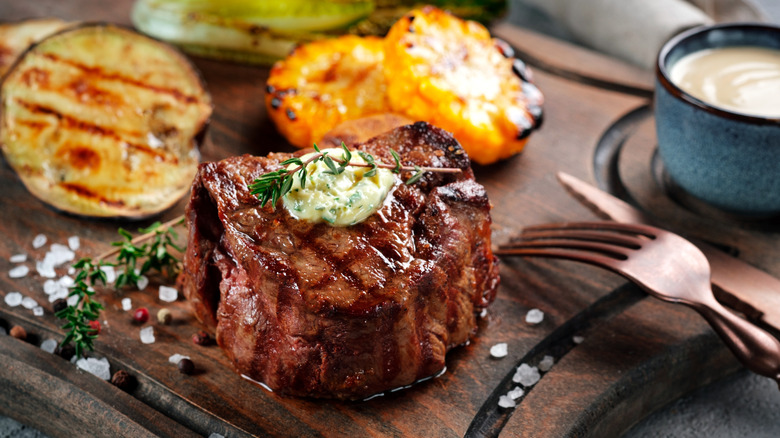11 Things You Should Think Twice About Ordering From A Diner
Diners and the food we get at them are the stuff of legends here in the U.S. It's difficult to think about a cross-country road trip without a few diner stops. And for true diner-lovin' foodies, said road trip might include a stop at every diner in every town along the entire route of the trip, with the best diners inspiring a second go-round for good measure. Because diners hold such a tender and nostalgic spot in our hearts and in the history of American food culture, it's only natural that diner lovers want a superlative dining experience at every turn. While this may not be fine dining, those who know good diner food also know bad diner food when they taste it.
For those who didn't grow up going to diners, a little tutoring is in order. The inexperienced but soon-to-be big diner fan should know what to order on the average diner menu and what to avoid. That is the purpose of this post: To guide those who aren't sure what makes for an amazing diner experience and what's better to just skip. Some of the recommendations are purely for taste reasons. Others speak to good health. Still, others touch on food experiences that are best had elsewhere besides the diner, which hopefully leaves would-be diner lovers with a better idea of what to order by eliminating the potential not-so-great dining experiences first. Here goes.
1. Eggs Benedict
Poached eggs done right are a special kind of delicious. They evoke the wholesomeness of morning sunshine on a crisp fall morning on a rural farm in the middle of America. Even those of us who didn't grow up on a farm appreciate the taste of poached eggs, particularly when they top other delicious ingredients, such as Canadian bacon or smoked lox. Add a toasted English muffin, a ladle of homemade hollandaise sauce, and some crisp hash browns, and it's a breakfast to remember for days.
There's a problem with all of this, of course. Most of us can't whip up eggs Benny, for a variety of reasons. During the work week, it comes down to too much work and too little time. While there's more cooking time on the weekend, the lack of the Benny boils down to the inability to make a properly poached egg, which is why we often head to the local diner to satisfy our craving.
This reveals another challenge, two challenges, actually. First, unless the cook has Olympic-level poached egg-making skills, the egg could possess a sturdy (like a brick) yolk. The second problem is the hollandaise sauce. Celebrity chef and street food champion Anthony Bourdain said in his book "Kitchen Confidential" that most restaurant hollandaise isn't made to order. This means you're competing with bacteria for your breakfast. So, unless you know the diner's reputation and its eggs Benny, it's best to skip the dish at an unfamiliar diner.
2. Chicken fried steak
How can an item that pretty much epitomizes the diner experience, chicken fried steak, be on a don't-eat list for diners? Really, you haven't eaten at a diner until you've ordered up a plate of chicken fried steak topped with white country gravy and flanked with a Mount Everest-sized mound of mashed potatoes, also covered with said gravy. And if it's a real, bonafide diner, the kind where employees start and end their careers, it'll come with a side of green beans for good measure. To say that the dish encapsulates greasy-spoon diner deliciousness understates the taste of this gastronomic wonder.
Chicken fried steak also epitomizes the kind of nutrient list that would endear you to those who love to visit themed restaurants around the world, like the Heart Attack Grill. Per FitBit, each serving of chicken fried steak is infused with 1,200 calories. Its fat content comes in at 58 grams and represents 89% of the recommended daily allowance for fat. A full 70% of that is saturated fat. And if that weren't enough, it contains 3,240 milligrams of sodium. We're almost positive you'd get less sodium if you just opted to drink down half of the Indian Ocean.
In all fairness, it does garner some points for dietary fiber. You'll get 10 grams in your average serving, plus some protein, of course. However, if you're worried about your arteries or your heart, it's best to skip it on your next trip to the diner.
3. Fettuccine Alfredo
Word has it that Olive Garden fettuccine Alfredo ranks at the top of its list of most popular items, and for those who don't cook, the dish can seem like wizardry on a plate. But really, fettuccine Alfredo works rather simply. You just blend together a bit of butter, Parmesan cheese, garlic, heavy cream, and other spices, and out comes the fettuccine Alfredo sauce we all know and love so much.
So, why is this lesson on the most popular dish at the Olive Garden when this article is about what not to order at a diner? Here's the truth. While some may equate making a good plate of Alfredo with being able to build a rocket ship to the moon, it's actually not a complicated dish to make. Further, it really tastes better at restaurants that specialize in making Italian pasta.
Now for the whopper — it costs a restaurant about three bucks, give or take, to make fettuccine Alfredo. You'll pay almost $12.00 for a serving of fettuccine Alfredo at most diners. That's an incredible markup for something that costs $3 to make. When it comes to ordering the dish when you're having dinner out, either opt for a place that specializes in Italian dishes to make it worth the splurge or make it at home. Given all the yummy desserts and practically gourmet burgers you'll likely find at the local diner, we recommend skipping the white cheesy pasta and opt for a diner specialty instead.
4. Fish and chips
Ordering fish in a restaurant poses a tricky proposition for many restaurant goers. Fish counts among those foods that need to be really, really fresh to not only taste good but also safe to eat. There are a few things you can look for if you're trying to decide whether or not to order fish in a diner. First, ask yourself if the place where you're eating is known for its fish, meaning are you eating at a diner near the ocean or in a place near one of the Great Lakes, like Wisconsin? If so, then eating that diner fish is probably okay. Second, consider whether or not the fish being served is in season. For example, ordering fish and chips made from Alaska polluck at any time during the main summer months is probably a no-go because the fish is out of season. It'll likely be frozen, and the quality will be lacking because of it.
Finally, it's worth mentioning that any time you fry food, you up the amount of bad-for-you components, like cholesterol and fats, and often an abundance of sodium to boot. If you're concerned about heart health, fish and chips probably isn't your best bet. The average serving of fish and chips, which can be as little as one piece of fish, comes in at nearly 19 grams of fat, according to Calorie King. A diner fish and chips dinner with three pieces of fish practically pickles your heart in bad stuff.
5. Fried zucchini
Fried zucchini is one of the most common items you'll find on diner appetizer menus. It just makes sense. The dish takes just a hot minute to make. The cost runs low. And in a pinch, it can save a Saturday night rush when getting dinner orders out takes longer than it seems like it should, and restaurant guests feel hangry as a result. A plate of fried zucchini pacifies the hangries until dinner comes.
However, anyone who's ever worked in a busy restaurant can tell you food often sits under the heat lamps for a while during dinner rush. There are too many orders to get out and insufficient servers to do the job. This doesn't bode well for dishes like fried zucchini because the combination of the heat from the lamp and the moisture that collects on the greasy cooked food turns dishes like fried zucchini into soggy zucchini. The once-crispy breaded coating loses its crisp mojo.
Aside from not looking appetizing to eat, the soggy zucchini becomes a breeding ground for bacterial growth within just two hours. While it probably won't sit under the heat lamp for two hours, it may sit on your table for an hour or two as you casually chat over dinner. In that case, you may find yourself eating a side of salmonella or E. coli with a side of Sriracha mayo. This is a dish that's better skipped if you're in the restaurant during the dinner rush.
6. Dinner rolls
Dinner rolls represent such a guilty pleasure in the era of keto and Atkins diets. Aside from maybe mac and cheese, few foods equal comfort quite like a well-buttered dinner roll. Even before its essence tickles your taste buds, the scent of it brings back, as Marcel Proust would say, "remembrances of things past." For many of us bread lovers, a basket of dinner rolls brings back memories of a fried chicken supper at grandma's, complete with honey-buttered rolls. And we usually bring these memories to dinner at the local diner.
The reality is something different, however. Most restaurants keep their dinner rolls in a bread warmer so that they're warm when it's time to serve them. After an eight-hour shift, those warm dinner rolls become warm rocks. The heat from the heated bread drawer eventually dries the bread out. Ideally, bread should be stored in a cool, dry place, away from air and moisture. The bread drawer is the opposite of this. While no moisture is directly added, many restaurants keep the rolls in the plastic bag they came in, which eventually starts to sweat. And the drawer is hardly cool. As for keeping the bread away from the air, the number of times the roll bag is opened during a shift means the bread may as well be out on the counter. Our verdict? Unless the bread comes as part of the dinner, like on the side of a large salad, avoid ordering it.
7. Salads as a meal
We're the first to admit it. People often visit diners because they want to eat a plate full of food that will stuff them to the gills and then some. No one expects to leave a diner with an empty tummy and an even emptier heart, but that's what can happen if you opt for a salad as a meal at diners. Blame this on the items that make up many dinner salads in diners, which include iceberg lettuce, celery, cucumbers, and radishes. They're also not always the most satisfying veggies from a taste standpoint, either. Lots of better-tasting, more calorically satisfying veggies do exist, like avocado or sweet potatoes.
This leads us to the second challenge that diner salads present. People often order a salad because they think it's a healthier choice. While some diner salad greenery does leave a lot to be desired, the bigger issue is what comes on those salads. The common Cobb salad isn't just salad greenery. It also comes with slices of turkey and sometimes ham, grated cheese, sliced eggs, and plenty of fatty dressing. For example, 1 ounce of blue cheese contains 8 grams of fat and 326 milligrams of sodium. And two tablespoons of ranch brings 13 grams of fat to dinner. If you're looking for healthier fare from a diner, you'd be better off ordering steamed fish with a side of vegetables. It's probably more satisfying in terms of taste and content and better for you, too.
8. Ice in your soft drinks
When the temps hit 100 degrees Fahrenheit, few things sound better than a glass of vanilla Coke with lots of ice to go with your lunch. Between the sweet fizzies and the big chunks of ice causing your glass to have a satisfying layer of "sweat," few things hit the spot more. And few things have more potential to make you spit up due to cross-contamination. If you've never really given much thought to your restaurant ice, you should for this reason.
The ice machines at diners come into contact with more than just ice cubes. Anyone who's working has potentially put their hands in the ice machine while they're scooping ice for soft drinks and to put on the cooking line. Even if they use an ice scoop, the handle of the scoop gets, shall we say, handled a lot. Aside from this, it's common for a person's knuckles and other parts of the hand to graze the ice, even with a scoop.
The ice machines from which the diner's staff gets their ice have the potential for mold and bacterial growth, depending on how well and how often the ice machine gets cleaned. If it's not cleaned to the degree that would make even Mr. Clean smile with pride, there's a potential for something to grow in the ice. Since you may not be familiar with the diner's ice machine cleaning routine, you may want to skip the ice in your drinks.
9. The daily special
If you're on a minimalist bent or are at all frugal, we bet you'll totally get what we're about to say next. You plan a special leftovers night to use up everything in the fridge that's threatening to go bad. If that means you eat a dollop of black-eyed peas alongside some Asian fried rice and the nachos left over from your visit earlier this week to the local Tex-Mex place, La Fiesta, then so be it. The leftovers get eaten, and nothing becomes a science experiment because it has been sitting in the fridge too long. It's a win-win, albeit an unusual one.
Did you know that diners and other restaurants have their own version of leftovers night? It's called the daily special, and if it's up for grabs, you might as well ask if the restaurant has any black-eyed peas or fried rice to go on the side with that. The fact is, many restaurants run specials because they have food they need to get rid of before it goes bad.
It could just be a dish that the cook really likes and wants you to like, too. But if your server is selling it hard and it's a mid-week day, like Tuesday or Wednesday, it's probably best to skip the special on your next trip to the local diner. That Wednesday special just might be made of ingredients that the cook ordered last week on Friday afternoon to prepare for the weekend rush.
10. Chicken
Unless we're traveling and just need to stop somewhere, anywhere, for dinner, most of us go out to dinner to connect with friends and to while away an evening. In other words, our need for sustenance and our desire for an evening's entertainment sends us looking for a memorable meal out, preferably one that tastes as delish as it hopefully looks in our Instagram photos.
Herein lies the potential problem with diner chicken recipes. They are hit or miss, great or terrible, photo-worthy or blah. In all fairness, a lot of restaurants, and not just diners, either do chicken really well or they don't. In more fine dining establishments, chicken, maybe because it is so common, sets the bar for the rest of the dishes. If the chicken's good, the rest of the dishes probably are, too. If the chicken leaves much to be desired, maybe the rest of the menu does, too. Or so the rationale goes.
While we certainly understand this reasoning, there may be another reason you should avoid the chicken. If the purpose of dinner out is partly for entertainment, you should order something you don't make for yourself at home regularly. Unless you're vegetarian or vegan, then chances are you eat nearly 55 pounds of chicken a year, per FlowingData, and most of it, you probably eat at home. If you're out to dinner, then you should eat something you don't usually eat at home.
11. Steak of any kind
We should say off the bat that it's not that you won't get a good deal on a steak at a diner or even that you can't find one that tastes relatively decent, and maybe even downright good in a roadside diner sort of way. But chances are you're going to get a cheap cut of steak, like chuck – aka Ranch steak – and while you may not pay a zillion dollars for it, you're going to get a very chewy steak for your buck. Sure, that 6-ounce Ranch steak and eggs breakfast or the steak dinner featuring a steak of equal size won't set you back much, but it won't be memorable, either.
Aside from that, it may do little to satisfy your hunger since the cut of steak is so small. How small, you might ask? Here's a comparison. The baked potato that you're eating with the meal will be larger than the steak itself. One of the arguments for going to a diner is to know that you won't leave the table hungry. With such small portions, that just might be the reality. So, while the steak will maybe cost you $10 or $11, you can usually order something else for a similar price and get way more food. And making a steak for yourself at home usually makes more sense financially and in terms of being a true, shall we say, appetite suppressant than the steak dinner you'll get at a nearby diner.
